The Art of Home Invasion Morphology and Behavior in Ctenocerinae (Hymenoptera: Pompilidae)
The Art of Home Invasion Morphology and Behavior in Ctenocerinae (Hymenoptera: Pompilidae) PDF File
Abstract
Several unidentified Pompilidae (spider wasps) share morphological similarities to that of Ctenocerinae, a subfamily known to contain species that hunt trapdoor spiders, but their behaviors remain unknown. Trapdoor spider hunting species have noticeable adaptations to their morphology, likely caused by specialized behaviors that allow them to prey upon these spiders and overcome their defenses. During this study we asked two main questions:
- Can morphological measurements be used to determine trapdoor spider hunting in spider wasps? and
- Has trapdoor hunting behavior evolved once or multiple times in spider wasps? In other words, is this morphology convergent?
To answer these questions, we gathered 31 specimens for analysis. This dataset included four from known trapdoor spider hunting spider wasp species, eight species that are known to hunt spiders other than trapdoor spiders, and 19 species from Australia with no known behaviors. We also generated a phylogeny using Ultra Conserved Elements (UCE) to determine relatedness between these 31 specimens. Through this study we were able to determine that morphology can help determine which species hunt trapdoor spiders and will likely aid in identification of those that even have features not as exaggerated as expected. Our phylogenetic analysis also indicated that evolution of this behavior has occurred multiple times in multiple groups.
Introduction
The subfamily Ctenocerinae contains species of spider wasps that are known to hunt trapdoor spiders (fig. 1) as their hosts. A trapdoor spider makes a burrow and covers it with a cork-like trapdoor made from vegetation, dirt, and silk. Trapdoor spiders will often escape predation by holding the door tight with their chelicerae and using their strong legs to brace themselves against the walls of their burrow. This makes the spider a formidable opponent for most predators. The female spider wasps that hunt these types of spiders have distinct morphologies that allow them to lift-up the trap door and sting the spider inside while avoiding the bite of the spider. These morphologies can include modifications of the head shape to avoid damage from the spider's fangs and swollen forelimbs (figs 2, 3, and 4) for lifting the door to the spider's home which the spider can normally hold tightly shut.
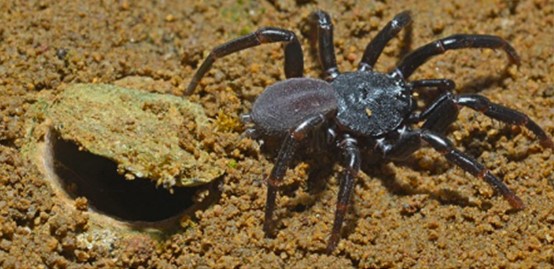
Photo by Nick Birke
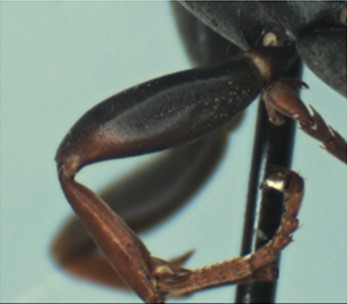
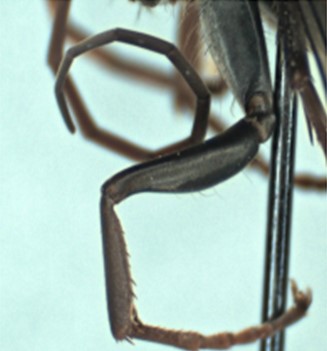
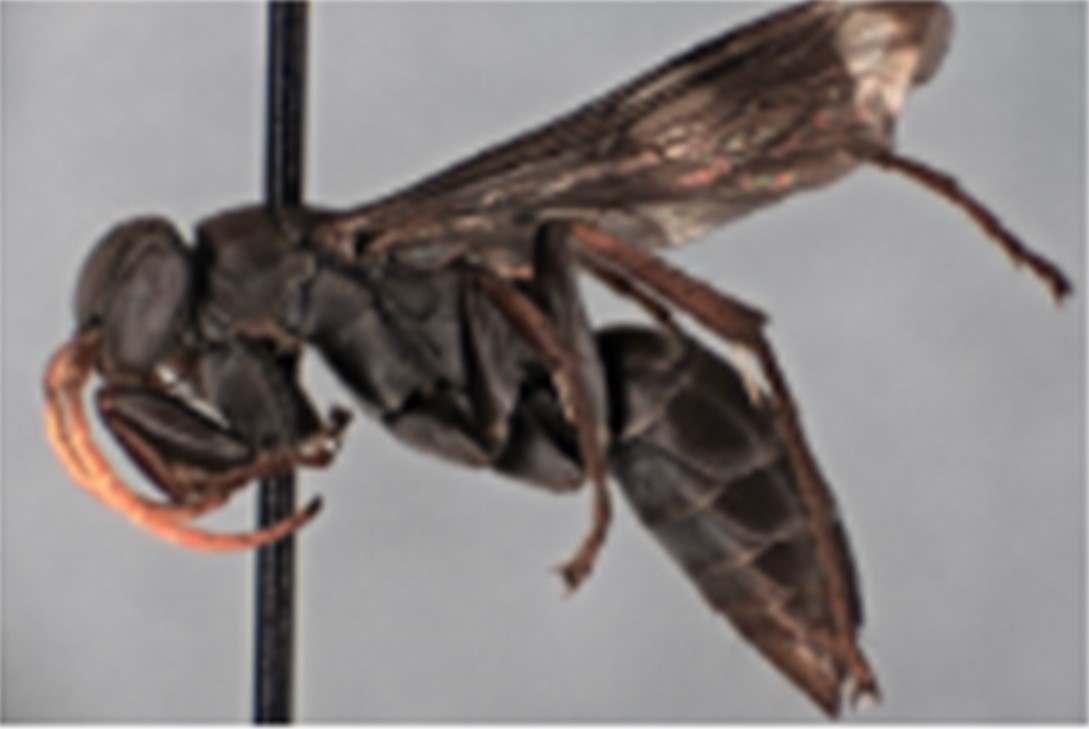
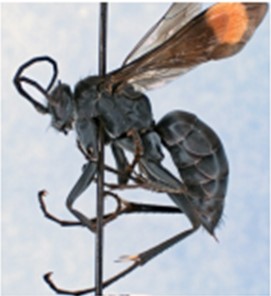
The female spider wasps exhibit these behaviors as they are the ones that will lay the egg on the trapdoor spiders. These morphologies are much more prominent in females than males.
Materials and Methods
Morphological Measurements
- The photographs measured were taken using a Leica microscope and ProgRes camera.
- Multiple images were stacked using Zerene Stacker to make the images clearer for measurement.
- All measurements were made with ImageJ and data were analyzed with Pisces Community Analysis Package, Ver. 4.
Molecular Work (UCE Capture)
- DNA was extracted from dried museum specimens using the Roche High Pure PCR Template Preparation Kit.
- Extracted DNA is mechanically sheared to a length of ~600bp (the optimal size for library preparation) using a Q800R2 Sonicator.
- Using speedbeads and a magnetic stand, the DNA fragments were cleaned and repaired and then each individual specimen was tagged with a unique identifier.
- DNA was pooled, enriched and submitted as one lane to an Illumina sequencer.
- Raw sequence data was cleaned and contigs were produced using PHYLUCE. The final dataset was analyzed using Maximum Likelihood through the program IQTree.
Results
- Can morphological measurements be used to determine trapdoor spider hunting in spider wasps?
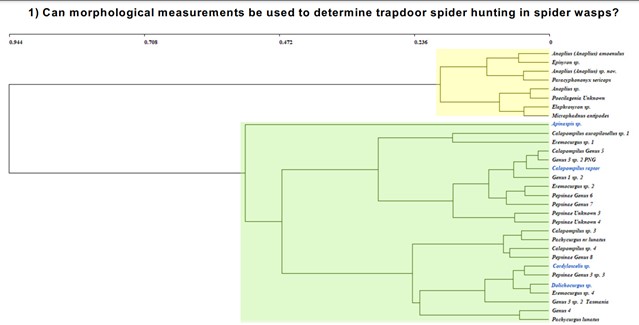
- Has trapdoor hunting behavior evolved once or multiple times in spider wasps? In other words, is this morphology convergent?
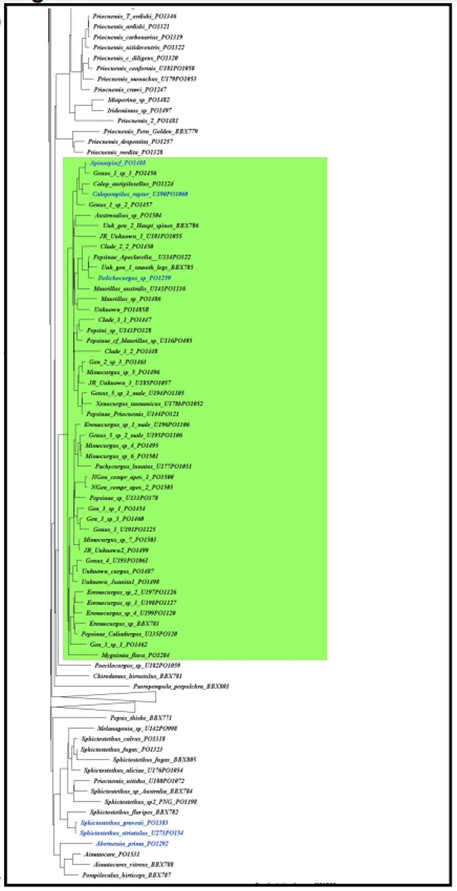
Figure 7. Results of the Maximum Likelihood analysis of UCE data. Specimens included in this phylogeny are from all over the world. The Australian specimens from the first part of this project (that are assumed to have specialized trapdoor spider hunting behavior) are once again highlighted in green. All known trapdoor spider hunting species are once again indicated with blue text, and any clade where this behavior has evolved is indicated with a black circle ( ) in the full phylogeny to the left. The phylogeny is significant (includes over 400 species) so a portion has been blown up in size for easier viewing.
Discussion
- Can morphological measurements be used to determine trapdoor spider hunting in spider wasps?
- We can confidently say from the results of this project that this specialized behavior (trapdoor spider hunting) can be determined by morphological analysis.
- In our analysis, we were able to cluster known trapdoor hunting species from the measurements we made (fig 6).
- We were also able to identify a number of species that are likely to prey on trapdoor spiders who currently have unknown hunting behaviors (fig 6).
- Has trapdoor hunting behavior evolved once or multiple times in spider wasps? In other words, is this morphology convergent?
- Our molecular analysis shows that this behavior has evolved at least 8 times (fig 7).
- This means that these morphological adaptations for hunting trap door spiders are convergent.
- The subfamily Ctenocerinae, as currently defined, is paraphyletic and the subfamily-level classification of Pompilidae needs re-evaluation.
Future Work
Now that we are confident that this behavior (and morphology) is convergent, we can look more closely at these groups to better determine which specific adaptations are tied to trapdoor spider hunting (example morphology in figs 8, 9). We can now assess variations between species that hunt the same spiders and better use morphology to predict behavior. This is incredibly beneficial considering these behaviors are incredibly difficult to observe in the natural world and impossible to observe in the lab.
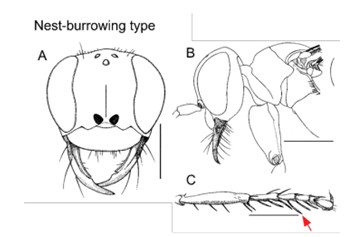
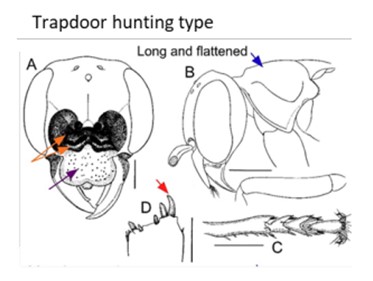
Citations
- Evans, Howard E. Wasp Farm. Natural History Press, Garden City, N.Y., 1963
- Shimizu, Akira, et al. "Systematics and Convergent Evolution in Three Australian Genera of Pepsinae Spider Wasps (Hymenoptera: Pompilidae)." Austral Entomology, 2021, doi:10.1111/aen.12530.

